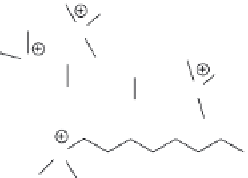Biomedical Engineering Reference
In-Depth Information
NH
2
NH
2
HN
HN
N
N
NH
2
X
X
H
NH
2
H
2
N
n
Reflux, 24 h
NH
H
2
N
NH
2
NH
HN
N
HN
C
8
H
17
X, reflux, 24 h
H
NaHCO
3
, reflux, 24 h
H
I
I
N
N
I
CH
3
I, 42
º
C, 48 h
NaHCO
3
, 42
º
C, 24 h
N
N
N
I
N
SCHEME 3.1
Synthesis of QPEI nanoparticles.
and methylation may also raise its positive charge by converting the PEI's primary, secondary, and
tertiary amino groups into quaternary amino groups. Studies on PEI nanostructured samples, modi-
fied with various alkylation agents based on alkyl bromides, evaluated their antibacterial properties
as a function of the alkyl group length
[43]
. The alkyl halides of eight methylene groups were more
preferred.
The effect of quaternization degree on the antibacterial activity of QPEI was also studied. It was
reported that the antibacterial effect was strengthened with the increase of the quaternization degree
[46]
.
Theoretically, positively charged quaternary ammonium groups strongly attract the negatively
charged microorganisms. Thus, higher electrostatic interaction will cause stronger adsorption toward
microorganisms, resulting in enhanced antibacterial activity.
3.4.1.2 Characterization
The antibacterial activity of QPEI nanoparticle incorporated in restorative composites was stud-
ied with respect to molecular weight of PEI, degree of crosslinking,
N
-alkyl chain length and
N
-methylation
[45]
.






































